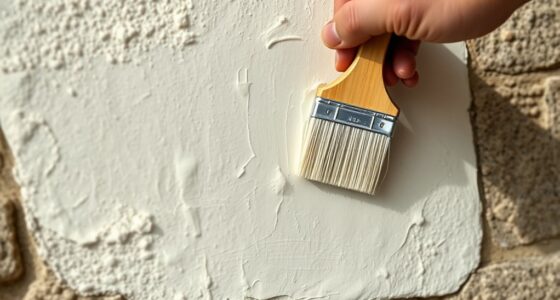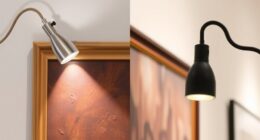To avoid common hanging mistakes, choose the right hardware and anchors that match your wall and weight of the items. Be sure to measure and plan placement carefully so everything stays level and spaced properly. Don’t overload hooks or hang items that are too heavy for your hardware. Also, consider environmental factors that could weaken your fixtures over time. Keep these tips in mind to hang securely and safely; more tips await to help you perfect your project.
Key Takeaways
- Select the correct hardware and anchors compatible with your wall type and item weight.
- Measure and level carefully to ensure proper placement and avoid crooked or unstable hangings.
- Do not overload hooks or hang heavy items beyond their weight capacity.
- Choose durable hardware suited to the environment to prevent deterioration over time.
- Plan layout and assess wall material to prevent rework, damage, or safety hazards.
Choosing the Wrong Hardware and Anchors

Selecting the right hardware and anchors is vital for a secure hang. You need to understand the different types of anchors available, such as toggles, molly bolts, or screw-in hooks, and choose the ones suited for your wall or ceiling material. Not all anchors work with every surface, so hardware compatibility is key. For example, heavy items require heavy-duty anchors, while lighter objects can use simpler options. Check the weight rating and ensure your hardware matches the type of anchor you select. Using incompatible hardware can lead to failure, risking damage or injury. Take the time to assess what you’re hanging and select anchors designed for that purpose. Proper hardware and anchor selection provide the foundation for a safe, secure hanging. Additionally, understanding the appropriate climate control measures can help prevent damage to your hanging items caused by moisture or temperature fluctuations. Being aware of hardware durability ensures your setup remains safe over time and withstands environmental factors.
Improper Placement and Spacing

Have you ever hung an item only to find it tilts or falls because of poor placement? Proper placement and spacing are essential for a balanced, secure display. Start by measuring distance carefully to ensure your piece hangs at the right height and is centered. Use a level to keep everything straight. When selecting materials, choose strong hooks or hangers suited for your wall type and weight. Avoid spacing items too close or too far apart, which can disrupt the visual flow or cause instability. Take your time to plan the layout before drilling or installing. Accurate measuring and thoughtful material selection prevent crooked or unstable hangings, saving you frustration and rework later. Proper placement isn’t just about aesthetics—it’s about safety and longevity. Incorporating vertical storage solutions can further optimize space and improve overall organization in your display setup. Additionally, understanding load distribution can help prevent sagging or uneven stress on your wall, ensuring your items stay secure over time. Paying attention to wall material compatibility can also help select the most appropriate hanging hardware and techniques, reducing the risk of damage or failure. Moreover, engaging in creative practice can help you develop better skills for planning and executing such projects, leading to more satisfying results.
Overloading and Weight Misjudgments

Even if your hooks and hangers seem sturdy, overloading them can lead to accidents or damage. Always verify the weight capacity before hanging anything heavy. Misestimating weight is a common mistake that can cause hooks to bend or fall, risking injury or damage. Remember, the weight capacity isn’t just a suggestion—it’s a limit designed for safety. If you’re unsure about an item’s weight, use a scale or distribute the load across multiple hooks. Overloading not only weakens your hanging points but also compromises your wall’s integrity. Understanding industry trends can help you better select appropriate hardware for your specific needs. Properly appraising weight ensures your hangings stay secure and your space remains safe. Being cautious with weight helps prevent mishaps and prolongs the life of your hooks and walls. Additionally, understanding business intelligence can help you better manage and plan your home projects efficiently. Using the right hardware specifications ensures safety and durability over time. Always consider the weight limits of the hooks and hangers, as exceeding these limits can lead to unexpected failure.
Frequently Asked Questions
How Can I Identify the Best Hardware for Different Wall Types?
To identify the best hardware for different wall types, start by examining your wall. For drywall, use sturdy wall anchors designed for weight; for concrete or brick, opt for masonry anchors or plugs. If you have plaster or drywall alternatives, select anchors that suit their material. Always check the weight capacity and compatibility of the wall anchors to guarantee secure hanging, preventing damage or accidents.
What Are Signs My Hanging Setup Is Insecure?
If your hanging setup feels insecure, look for signs like uneven weight distribution or hardware that feels loose. You might notice the hook or nails shifting, or the item tilting or sagging. Make sure your hardware is compatible with your wall type, and check that it’s anchored properly. If anything seems unstable, re-evaluate your hardware choice and installation to prevent accidents or damage.
How Do I Determine the Correct Spacing Between Hooks?
Think of your hanging setup as a delicate dance—each step must be precise. To measure distance, use a ruler or tape measure, ensuring hooks are evenly spaced and aligned. Proper hook placement depends on the artwork’s weight and size; heavier pieces need more support and wider spacing. Check that hooks are securely anchored and level, balancing the visual harmony and safety of your display.
What Are the Risks of Using Too Much Weight on a Hanging Object?
Using too much weight on a hanging object risks weight overload, which can lead to structural failure. When you overload the hooks or support, they may bend, break, or detach unexpectedly, causing injury or damage to your space. Always check the weight limit of your hanging hardware and avoid exceeding it. Properly distributing weight and ensuring sturdy support minimizes these risks and keeps your setup safe and secure.
Can I Hang Heavy Items on Drywall Without Special Anchors?
Imagine the drywall as a delicate stage—can it bear heavy items without proper support? You shouldn’t hang heavy objects on drywall without special anchors because weight distribution matters. Choosing the right anchors guarantees your items stay secure and prevent damage. Without proper anchor selection, your heavy hangings risk falling, causing damage or injury. Always opt for appropriate anchors designed for weight and drywall strength to keep your belongings safe and secure.
Conclusion
Avoiding common hanging mistakes is like building a sturdy bridge—you need the right materials, placement, and weight limits. I once hung a picture with the wrong anchors, and it came crashing down during a breeze. That taught me the importance of proper hardware and spacing. When you pay attention to these details, your decor stays secure and beautiful. Remember, small mistakes can cause big mishaps, so take your time and hang with confidence.









